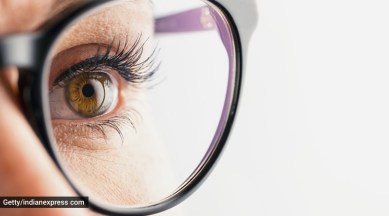📣 For more lifestyle news, click here to join our WhatsApp Channel and also follow us on Instagram
This is why some people see colours differently
Colour perception is subjective, and there is no universal standard for what colour should look like, said Dr Ajay Sharma, chief medical director, EyeQ

At some point, you must have been baffled by an optical illusion that appears to be in a different colour to you than someone else. But what you ever wondered why this happens? Does it mean that some people see or perceive colours differently? While the answer is complex, experts said that it ultimately comes down to the differences in the way the brain and the eyes interpret colour. Fascinating, we say! So, if you, like us, wish to decode this puzzle, join us on our quest to find out all the answers.
How do the eyes (and the brain) work?
monthly limit of free stories.
with an Express account.
The human eye contains three types of colour-sensing cells, known as cones, that are responsible for detecting red, green, and blue light. “These cones work together to create our perception of colour. However, some people may have a genetic variation that causes them to have a different number or type of cones, which can result in differences in colour perception,” said Dr Jayapal Reddy, senior ophthalmologist, Kamineni Hospitals, Hyderabad.
Describing the science behind how our brain and eyes work in tandem, Dr Ajay Sharma, chief medical director, EyeQ, said, “When we see an object, light reflects off the surface of the object and enters our eyes. The cone cells in our eyes then send signals to the brain, which interprets these signals as colour.”
Factors affecting colour perception
Colour perception is subjective, and there is no universal standard for what colour should look like, Dr Sharma mentioned.
However, experts stated that there are some factors to consider when evaluating colour perception, such as whether a person’s perception of colours is consistent over time and across different lighting conditions.
One reason why people may perceive colour differently is due to individual variations in the number and sensitivity of cone cells. Some people may have more or fewer cone cells than others, or their cone cells may respond differently to certain wavelengths of light. “For example, someone who has a higher number of cone cells that are sensitive to green light may perceive greens as more vibrant than someone who has fewer green-sensitive cone cells,” said Dr Sharma.
According to Dr Reddy, another factor that can affect colour perception is age. “As we get older, the lens of the eye can become less clear, causing colours to appear less vibrant or to shift in hue. Certain medical conditions, such as cataracts or macular degeneration, can also affect colour perception,” Dr Reddy told indianexpress.com.
Additionally, Dr Sharma pointed out lighting conditions as another factor that can affect colour perception. “Different light sources emit different wavelengths of light, and this can affect the way we perceive colours. For example, fluorescent lighting tends to have a blue-green tint, which can make colour appear cooler and more subdued. On the other hand, incandescent lighting tends to have a warm, yellow-orange tint, which can make colours appear warmer and more saturated,” Dr Sharma described.
Even cultural and language differences can affect colour perception, Dr Sharma pointed out. “In some cultures, certain colour are associated with specific emotions or meanings. For example, in Western cultures, red is often associated with passion or danger, while in some Asian cultures, it may be associated with good fortune or happiness. Additionally, some languages may have different words for certain colour or may not distinguish between certain colours at all, which can affect how people perceive and describe colours,” Dr Sharma said.
What to keep in mind?
It’s important to note that while colour perception can vary from person to person, it’s not necessarily “wrong” or “right.” It’s simply a difference in perception that can be influenced by individual factors such as genetics and age.
When considering colour perception, there are a few things to keep in mind. “First, it’s important to be aware of any changes in colour perception that may indicate an underlying medical condition. If you notice a sudden change in the way colours appear, it’s important to consult with an ophthalmologist to rule out any serious conditions,” Dr Reddy recommended.
Concurred Dr Sharma, and said that an eye doctor can perform tests to assess your colour vision and determine if there are any underlying issues that may be affecting your ability to perceive colour accurately. “it’s important to consider factors such as consistency of perception when evaluating colour vision,” Dr Sharma added.
📣 For more lifestyle news, follow us on Instagram | Twitter | Facebook and don’t miss out on the latest updates!
📣 For more lifestyle news, click here to join our WhatsApp Channel and also follow us on Instagram